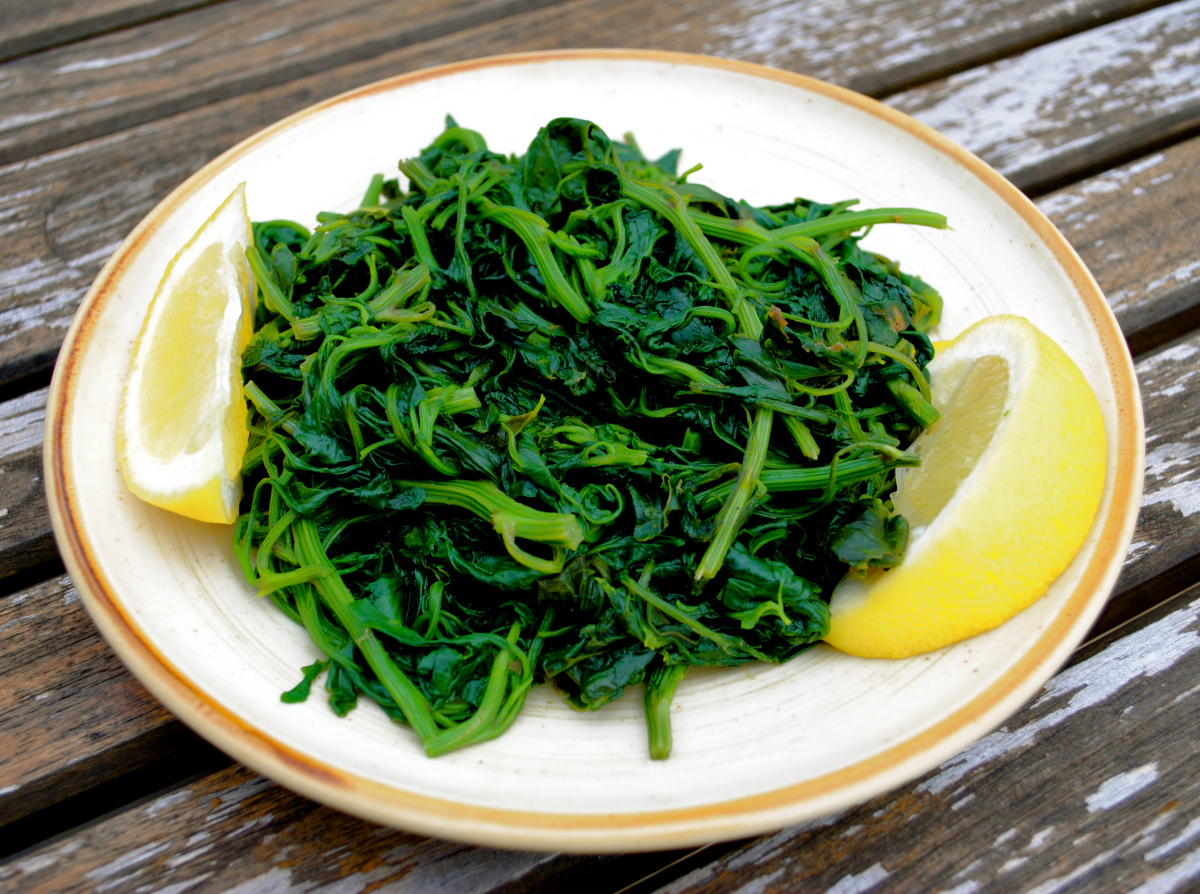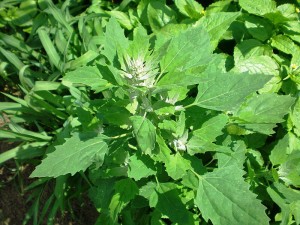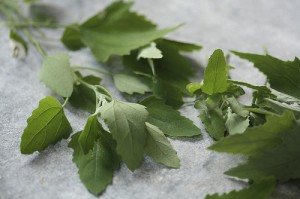Lamb’s quarters was a popular spring tonic in the South—an early season edible green—but its leaves are good throughout the summer.
Chenopodium album
Native range: Described by Linnaeus in 1753, this European native has been transferred throughout much of the world. Because its spread was rarely recorded, C. album‘s native and invasive status is sometimes obscure.
Invasive range: The European strain of Chenopodium alba has invaded the Lower 48, Alaska, Hawaii, Canada, and Greenland. There are native variants in parts of the Lower 48 and Canada.*
Habitat: Gardens, croplands, old fields, weedy meadows, edge habitats, even sidewalk cracks. Common in disturbed areas.
Description: Bushy appearance, tapering toward the top. Diamond shaped leaves are dusty white underneath. Upper leaves are smaller, narrower, and appear mealy from the presence of tiny white hairs, which are present on the lower and upper surfaces. The leaves are odorless when crushed. Stout stems. Dense spikes of small green flowers along the top branches. Also known as pigweed, fat hen, and the best descriptor of all, goosefoot, for the weblike tapered leaves.
In Edible Wild Plants of Eastern North America, the botanist Merritt Lyndon Fernald and Alfred Charles Kinsey, the renowned sexologist, recalled planning a dinner party for botanists that would feature a purée of fairy ring mushrooms, escalloped purslane, and lamb’s quarters bread. In January along the edge of a frozen truck-farm, they quickly gathered a peck of seeds, husks, and stems. Also in the cold, the seeds had to be winnowed outdoors to yield a quart of fruit: black, dry, ready to be ground:
“When the meal was served, Mrs. Fernald brought in the soup, which found favor, along with thin biscuits of Jack-in-the-Pulpit flour. Then came the Purslane and a salad, accompanied by some deeply black muffins. That plate went around the table, receiving one polite “No, thank you” after another until it reached the late Emile Williams, half-French and with more than usual Yankee consideration for others. He took one, put on his glasses, inspected and then sniffed it.
“‘Ah, Chenopodium album.
“Asked how he guessed, he replied, ‘I’ve just been reading Napoleon’s Memoirs. Napoleon at times had to live on it.’
“The plate was promptly cleared by the suddenly ravenous guests, and had to be refilled with more, which were polished off accompanied by the Beach-Plum preserve.”
Chenopodium album, a native of Eurasia, goes by various common names: lamb’s quarter, goose foot, pigweed, fat hen, all of them suggesting that the plant is more fit for animal consumption than human and yet human consumption of both leaves and seeds goes back at least to the Vikings. Early settlers, their animals, and fodder brought the plant intentionally and otherwise to North America, where it proved to be another perfectly designed invader ready to hop the garden wall.
A Few Early Observations
April 18, 1749. Chester, Pennsylvania. Both the Swedish and English settlers are in the spring accustomed to prepare greens from various plants . . . . They generally boil the leaves in the water in which they had cooked meat. Then they eat it alone or with the meat. It is served on a platter and eaten with a knife, which is different from the Swedish custom. Here also vinegar is placed in a special container on the table to be used on the kale. I must confess that this dish tastes very good. . . . In some places hereabouts there was a plant, the Chenopodium album L., which grew in great quantities in rich soil and was . . . used as kale. Only the young plants a few inches in height were used and prepared like the preceding one.
–Peter Kalm, Travels in North America
1825-26. Columbia River drainage, Northwest Territory. Botanical specimen #410: Chenopodium sp.; annual; plentiful in all rich soils; fertile banks of rivers; grows very strong and abundant around Indian villages and camps. . . among the numerous vegetables used by them it is rather singular they should omit one which is almost universally used in every country.
–David Douglas, Scottish botanist
1847. White Chenopodium. Vulgò–Lamb’s Quarters. Goose-foot.
Obs. This coarse and rather homely weed has become very extensively naturalized throughout the U. States,––and is quite troublesome in gardens. The young plant is sometimes used as a pot-herb; but would be gladly dispensed with by all neat gardeners and farmers.
–William Darlington, Agricultural Botany: An Enumeration and Description of Useful Plants and Weeds, which Merit the Notice, or Require the Attention of American Agriculturists
*If you are a diehard invasivore, restrict your consumption to Alaska, Hawaii, Greenland, and the St. Pierre and Miquelon islands.
Harvest
Young tender plants, less than a foot high, are the tastiest. Young plants can be found, especially near cultivated ground, from midspring until frost. Young leaves are egg shaped, with toothed margins. They are dull green on top, dusty white on the underside. Back in the kitchen, make sure to rinse well.
Wildman Steve Brill notes that all the leaves are excellent throughout the growing season, although you have to strip them off the branches when the plant isn’t young.
In fall or early winter, it is easy, if labor intensive, to gather the seeds, which form panicles at the end of each branch. Euell Gibbons suggests rubbing the husks over a pail between your hands to separate the seed and chaff. The small seeds are blackish brown. They can be roasted, at 300 degrees, and ground for baking or as a meal for breakfast cereal.
Recipes
Lamb’s Quarters Crostini
From the Sierra Club
4 cups lamb’s quarters leaves
2 to 3 tablespoons olive oil
2 tablespoons lemon juice
Salt to taste
1 whole head of garlic
1 loaf French bread, sliced into ½ inch slices
1 oz block of Parmesan cheese
Preheat the oven to 375°F. Rub one side of the bread slices with garlic. Place the bread on a baking tray, garlic side up, and bake for 8 minutes. Mince the rest of the garlic.
In the mean time, immerse the lamb’s quarters is a large bowl of water to remove all the grit. Grit doesn’t taste very good! Chop coarsely.
In a medium frying pan, sauté the olive oil and garlic over medium heat until the garlic is soft. Add the lambsquarter leaves and sauté for another 2 minute before adding the lemon juice. Remove from heat and allow to cool for 5 minutes. Top the bread slices with the lamb’s quarters mixture and a thin slice of parmesan cheese. Serve immediately.
Lamb’s Quarters and Beans
Adapted from The Crunchy Chicken and The Vegetarian Times, July 1997
1 pound lamb’s quarters
1 tablespoon olive oil
3 cloves garlic, minced
3 leeks, finely chopped
1 cup canned pinto beans, rinsed and drained
1 teaspoon chili powder
salt and pepper to taste
Rinse greens several times to make sure that all sand and grit are removed. Steam greens in a tightly covered pot until wilted. Drain and finely chop.
In a large skillet, heat oil over medium heat. Add garlic and leeks and cook, stirring frequently, until leeks are soft, 2 to 3 minutes. Stir in greens, beans, and chili powder. Cover and cook over low heat for 5 minutes or until heated through.
Season with salt and pepper and serve.
Makes 6 servings.
Links
Phoenix farms has posted several straightforward recipes, including lemony lamb’s quarters feta salad.
A straightforward heritage (read, with bacon or salt pork) recipe for Lamb’s quarters spring greens.
Read garden columnist Bill Finch’s prose ode to the lost custom of serving up lamb’s quarters (aka goosefoot) as a spring tonic in the South here.





























{ 9 comments… read them below or add one }
I put fresh, raw, lambs quarters leaves in my green smoothies. I like lambs quarters because it grows in our hot summer months when all the winter greens are finished or full of bugs.
Archeologists found remains of lamb’s-quarters seeds cultivated by Native Americans for food from before contact with Europeans. Muddy-footed migrating birds blown off course by storms probably transported the tiny seeds across the Atlantic in prehistoric times.
What do you do with the seeds?
Thanks, Duane. Steve Brill says that you can cook the seeds as you would any other grain, boiling them in water for about 15 minutes until they are soft like rice. For nuttier taste, toast them in a pan until they pop.
It’s also great for breakfast. The seeds can be stirred into oatmeal when you set it to boil or add them to cornbread, muffins, or pancakes.
Thanks, I might try that some day. I used to get a lot of this stuff at my last place, but it is pretty uncommon on my current spread. I always called it “goosefoot” and pulled it as a weed. I got some once in a salad of mixed greens at a local restaurant and thought it had just gotten in there by accident – actually, I still think that.
Lamb’s-quarters seeds are quite good to eat, only it’s rare to find them in enough quantity to make harvesting worthwhile. Amaranth is much more practical, with much greater harvests.
Good article, but I’d like to make a few corrections. All the leaves are excellent throughout the growing season, although you have to strip them off the branches when the plant isn’t young. The seeds are good, but quite labor-intensive to collect in any significant quantity. Amaranth is a much better choice in that respect.
Thanks, Steve. We’ll update this. Always love getting your view.
Thanks, Joe. Glad I can help. I always enjoy getting your newsletters.
BTW, everything I know about edible wild plants is in my iPhone/iPad/Android app, Wild Edibles (and in my books as well), which you might want to cross reference before publishing articles on the species it includes.